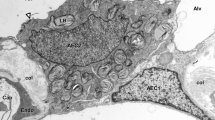Abstract
We hypothesized that the viscoelastic properties of the respiratory system should have significant implications for the energetically optimal frequency of breathing, in view of the fact that these properties cause marked dependencies of overall system resistance and elastance on frequency. To test our hypothesis we simulated two models of canine and human respiratory system mechanics during sinusoidal breathing and calculated the inspiratory work (\(\dot W\)) and pressure-time integral (PTI) per minute under both resting and exercise conditions. The two models were a two-compartment viscoelastic model and a single-compartment model. Requiring minute alveolar ventilation to be fixed, we found that both models predicted almost identical optimum breathing frequencies. The calculated PTI was very insensitive to increases in breathing frequency above the optimal frequencies, while\(\dot W\) was found to increase slowly with frequency above its optimum. In contrast, both\(\dot W\) and PTI increased sharply as frequency decreased below their respective optima. A sensitivity analysis showed that the model predictions were very insensitive to the elastance and resistance values chosen to characterize tissue viscoelasticity. We conclude that the\(\dot W\) criterion for choosing the frequency of breathing is compatible with observations in nature, whereas the optimal frequency predictions of the PTI are rather too high. Both criteria allow for a fairly wide margin of choice in frequency above the optimum values without incurring excessive additional energy expenditure. Furthermore, contrary to our expectations, the viscoelastic properties of the respiratory system tissues do not pose a noticeable problem to the respiratory controller in terms of energy expenditure.
Similar content being viewed by others
References
Bates, J.H.T.; Decramer, M.; Zin, W.A.; Harf, A.; Milic-Emili, J.; Chang, H.K. Respiratory resistance with histamine challenge by single-breath and forced oscillation methods. J. Appl. Physiol. 61:873–880; 1986.
Bates, J.H.T.; Brown, K.A.; Kochi, T. Respiratory mechanics in the normal dog determined by expiratory flow interruption. J. Appl. Physiol. 67:2276–2285; 1989.
Bates, J.H.T.; Shardonofsky, F.; Stewart, D.E. The low-frequency dependence of respiratory system resistance and elastance in normal dogs. Respir. Physiol. 78:369–382; 1989.
Cala, S.J.; Wilcox, P.; Edyvean, J.; Rynn, M.; Engel, L.A. Oxygen cost of inspiratory loading: Resistive vs. elastic. J. Appl. Physiol. 70:1983–1990; 1991.
D'Angelo, E.; Calderini, E.; Torri, G.; Robatto, F.M.; Bono, D.; Milic-Emili, J. Respiratory mechanics in anesthetized paralyzed humans: Effects of flow, volume, and time. J. Appl. Physiol. 67:2556–2564; 1989.
Gray, J.S.; Grodins, F.S.; Carter, E.T. Alveolar and total ventilation and the dead space problem. J. Appl. Physiol. 9:307–320; 1956.
Hantos, Z.; Daroczy, B.; Suki, B.; Galgoczy, G.; Csendes, T. Forced oscillatory impedance of the respiratory system at low frequencies. J. Appl. Physiol. 60:123–132, 1986.
Lutchen, K.R.; Jackson, A.C. Effects of tidal volume and methacholine on low-frequency total respiratory impedance in dogs. J. Appl. Physiol. 68:2128–2138; 1990.
Mead, J. Control of respiratory frequency. J. Appl. Physiol. 15:325–336; 1960.
Mount, L.E. Ventilation flow-resistance and compliance of rat lungs. J. Physiol. (Lond.) 127:157–167; 1955.
Otis, A.B.; Fenn, W.O.; Rahn, H. The mechanics of breathing in man. J. Appl. Physiol. 2:592–607; 1950.
Rahn, H.; Otis, A.B.; Chadwick L.E.; Fenn, W.O. The pressure-volume diagram of the thorax and lungs. Am. J. Physiol. 146:161–178; 1946.
Rohrer, F. Physiologie der Atembewegung. In: Bethe, A.T.J.; von Bergmann, G.; Embden, G.; Ellinger, A., eds. Handbuch der normalen und pathologischen Physiologie, vol 2. Berlin: Springer-Verlag; 1925: pp. 70–127.
Roussos, Ch.; Campbell, E.J.M. Respiratory muscle energetics. In: Mead, J.; Macklem, P.T., eds. Handbook of physiology: Section 3, the respiratory system, vol III, parts 1 and 2: Mechanics of breathing. New York: Oxford University Press 1986: pp. 481–570.
Suki, B.; Peslin, R.; Duvivier, C.; Farre, R. Lung impedance in healthy humans measured by forced oscillations from 0.01 to 0.1 Hz. J. Appl. Physiol. 67:1623–1629; 1989.
Yamashiro, S.M.; Grodins, F.S. Optimal regulation of respiratory airflow. J. Appl. Physiol. 30:597–602; 1971.
Yamashiro, S.M.; Grodins, F.S. Respiratory cycle optimization in exercise. J. Appl. Physiol. 35:522–525; 1973.
Yamashiro, S.M.; Daubenspeck, J.A.; Lauritsen, T.N.; Grodins, F.S. Total work rate of breathing optimization in CO2 inhalation and exercise. J. Appl. Physiol. 38:702–709; 1975.
Author information
Authors and Affiliations
Rights and permissions
About this article
Cite this article
Bates, J.H.T., Milic-Emili, J. Influence of the viscoelastic properties of the respiratory system on the energetically optimum breathing frequency. Ann Biomed Eng 21, 489–499 (1993). https://doi.org/10.1007/BF02584331
Issue Date:
DOI: https://doi.org/10.1007/BF02584331




